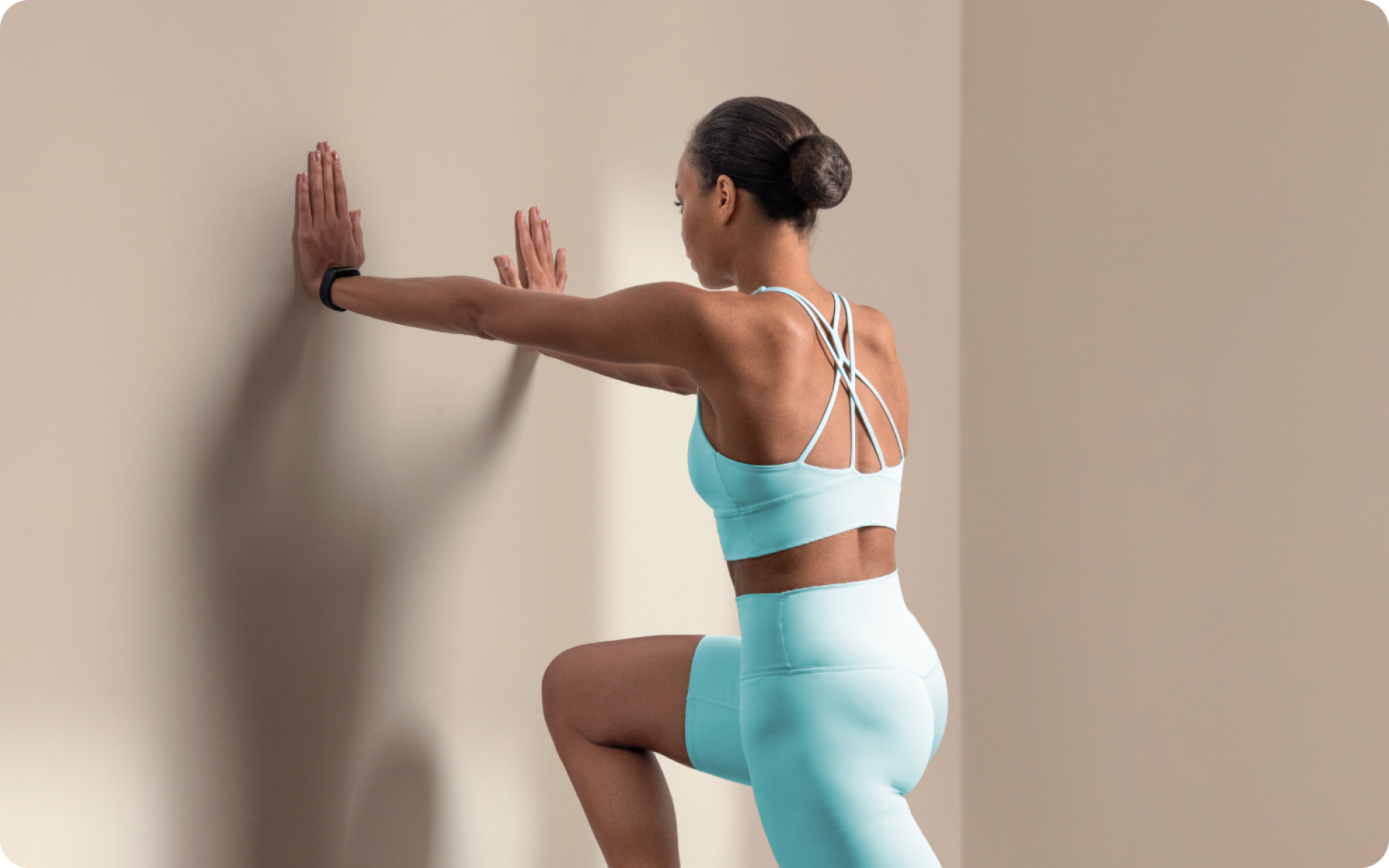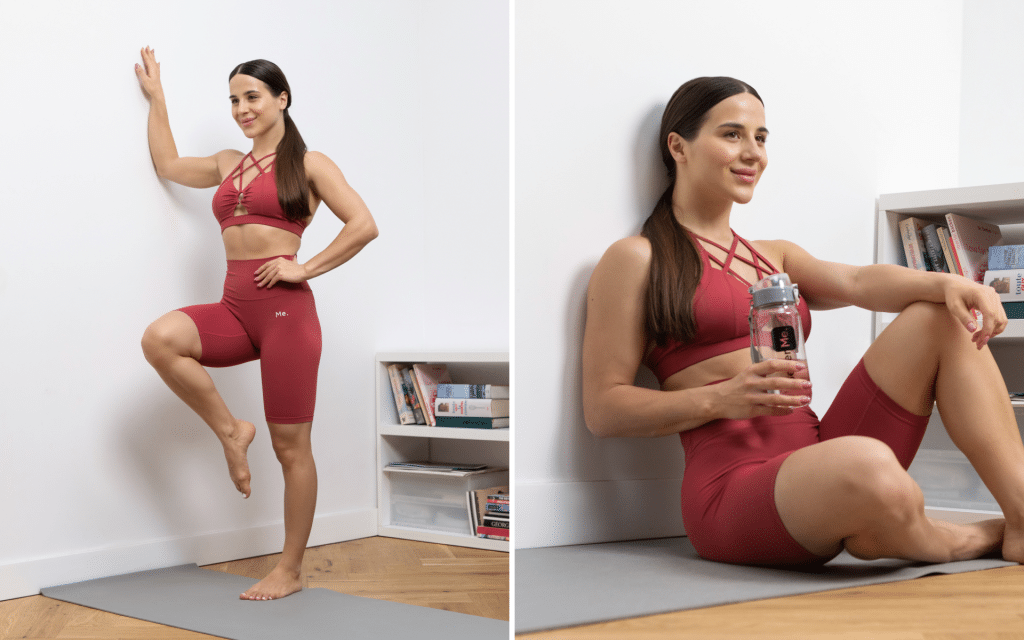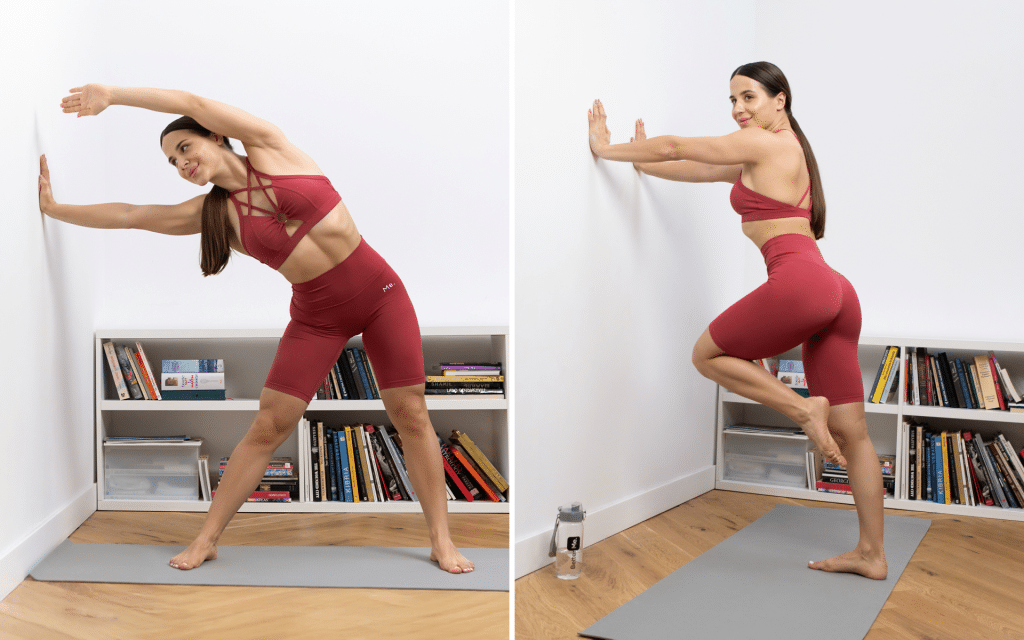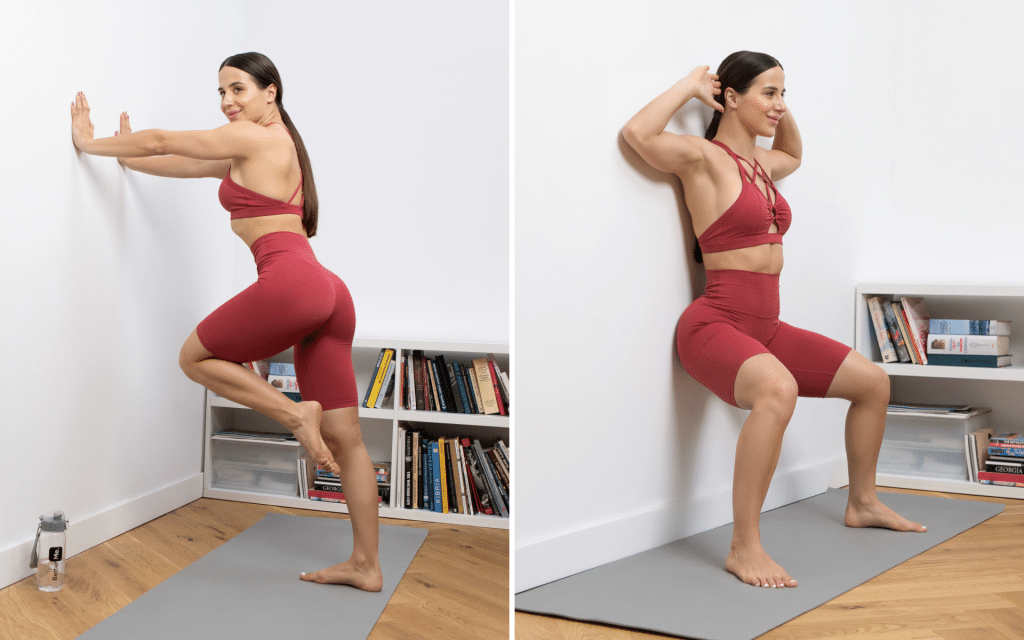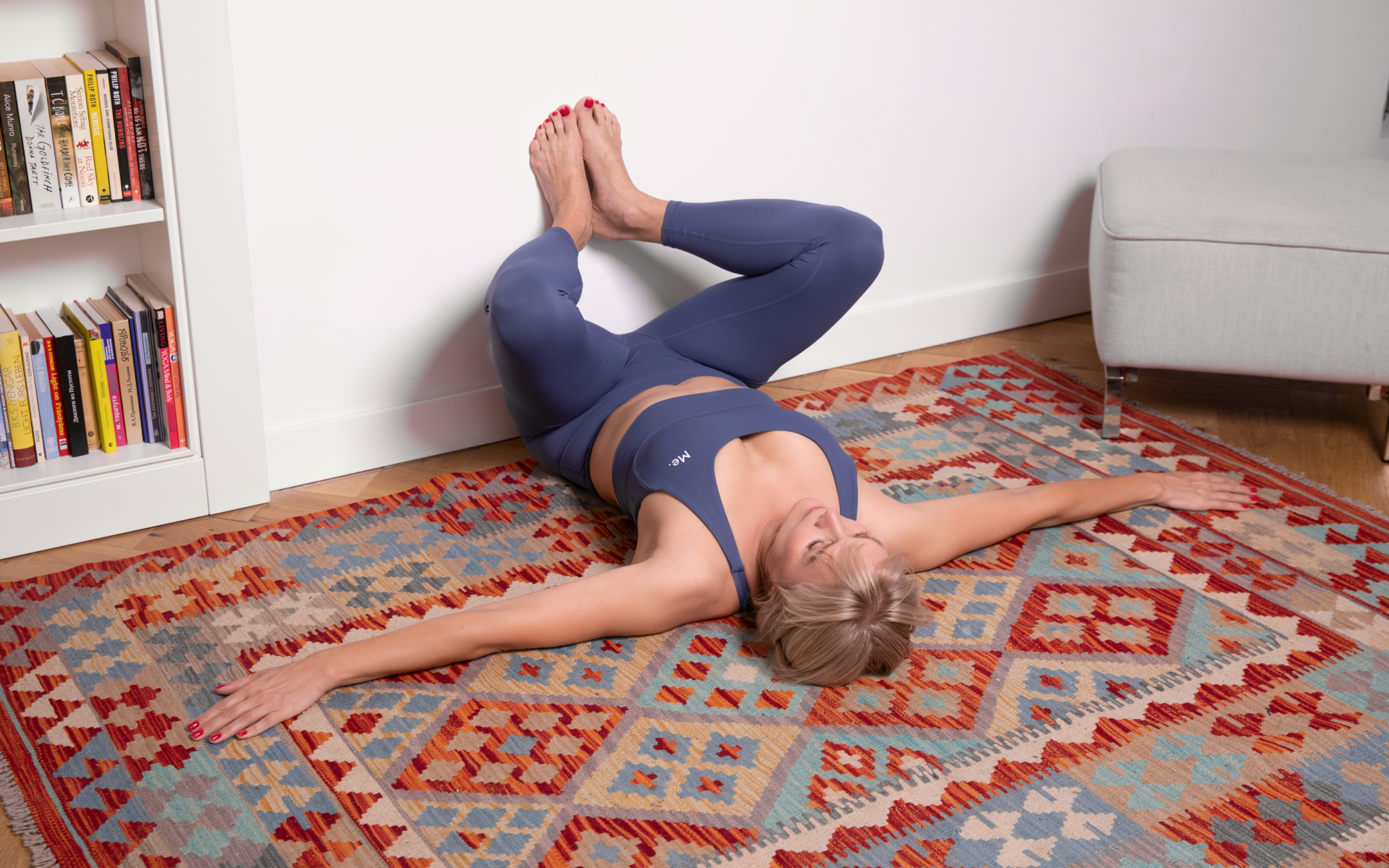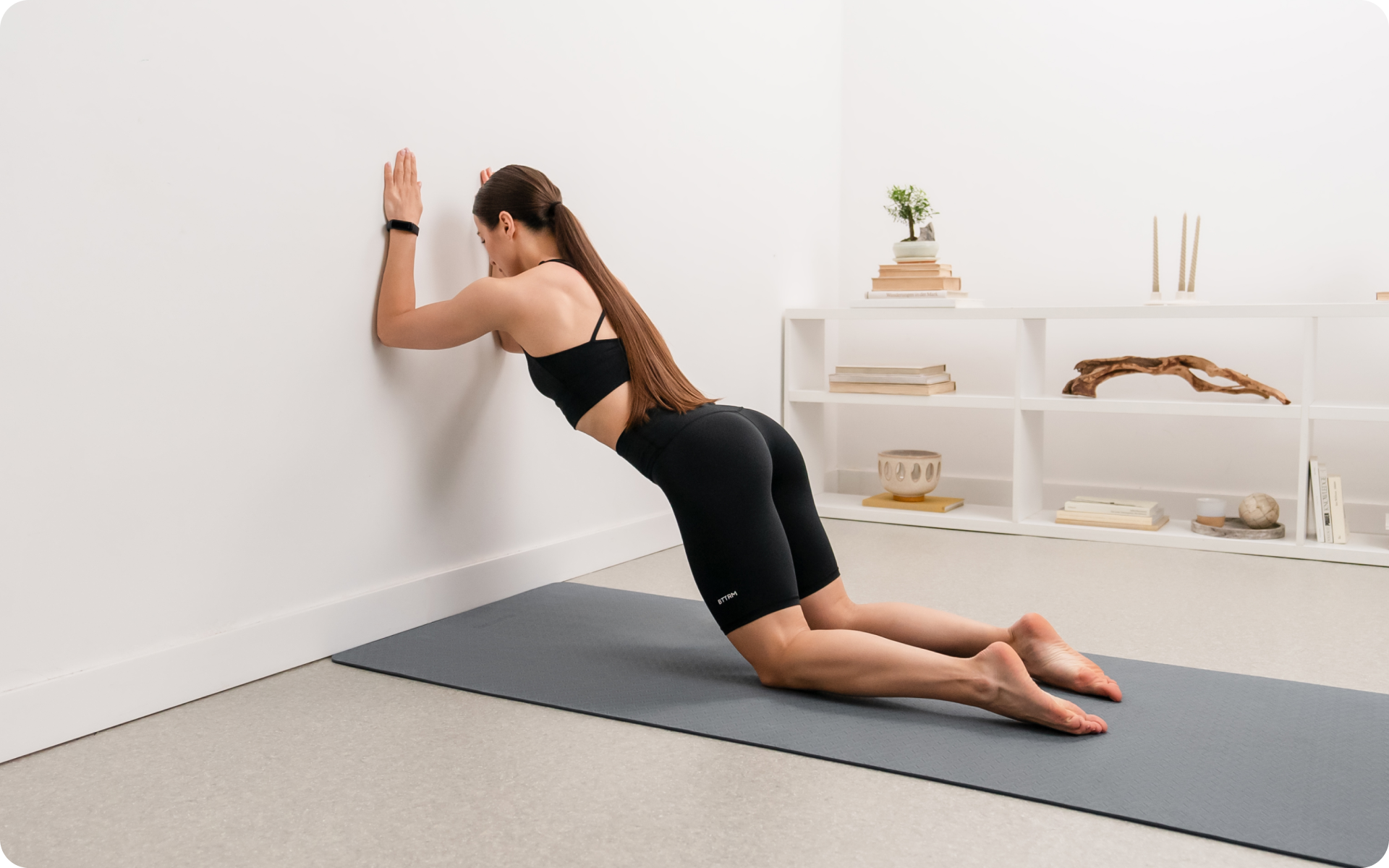Wall stands demand more than just static strength – they test your endurance, coordination, and form. By practicing complementary exercises, you prepare your body holistically, addressing areas that a single movement can miss.
For example, stronger wrists reduce strain during prolonged holds (1), a stable core enhances alignment (2), and flexible shoulders allow for smoother transitions into a vertical position (3).
With these 8 moves, you can build the necessary foundation to progress toward a handstand with proper technique and confidence.
What Is a Wall Stands Workout for Strong Hands?
A wall stands workout for strong hands focuses on fortifying the muscles, ligaments, and joints that bear the brunt of holding your body weight during a wall stand or, eventually, a freestanding handstand.
While wall stands themselves are fantastic for building strength, incorporating accessory exercises can help optimize your performance, prevent injury, and pave the way for achieving advanced gymnastic movements such as handstands.
The exercises below are specifically designed to strengthen the key muscles involved, train proper body alignment, and help you feel more comfortable being upside down.
Practice these consistently, and you’ll be ready to tackle a wall stand.
1. Plank Holds
Plank holds are foundational for building the core and shoulder strength you’ll need to support your body weight during a wall stand. They also improve your stability and teach you to keep your body in a straight line, which is essential for good handstand form.
How to do it:
- Start on the ground with your palms flat and directly under your shoulders and your legs extended straight behind you.
- Engage your core and make sure your body forms a straight line from head to heels.
- Avoid letting your hips sag or rise too high.
- Hold this position for 20-30 seconds, gradually increasing the time as you get stronger.
2. Pike Push-Ups
Pike push-ups strengthen the shoulders and triceps, which are key for holding your body in a handstand position. They also mimic the pushing motion required to balance upside down.
How to do it:
- Start in a downward dog position with your hands and feet on the ground and your hips lifted high.
- Walk your hands slightly closer to your feet to create a pike position.
- Bend your elbows to lower your head toward the floor while keeping your hips high.
- Push back up to the starting position and repeat. Aim for 8-12 reps.
Intense sweat sessions, working weight loss tips, lip-smacking recipes come in one package with the BetterMe: Health Coaching app—all at your fingertips, start transforming your life now!
3. Wall Walks
Wall walks are a fantastic way to get comfortable being upside down while strengthening your shoulders, core, and back. They also help you practice engaging the muscles needed for stability in a wall stand.
How to do it:
- Start in a plank position with your feet resting against the base of a wall.
- Slowly walk your feet up the wall while simultaneously walking your hands closer to it.
- Continue until you’re in a nearly vertical wall stand position (or as close as you’re comfortable).
- Hold for a few seconds, then carefully reverse the movement to return to the starting position.
- Repeat 3-5 times.
4. Hollow Body Holds
Hollow body holds teach you how to engage your core and maintain a straight, stable spine, which is essential for good form in a wall stand or handstand.
How to do it:
- Lie on your back with your arms extended overhead and your legs together.
- Lift your shoulders and legs off the ground, keeping your lower back pressed firmly into the floor.
- Squeeze your abs and point your toes to maintain a strong, hollow body shape.
- Hold for 20-30 seconds, or longer as you progress.
5. Dolphin Pose
This exercise builds shoulder and upper back endurance while reinforcing core engagement and alignment. It also helps increase flexibility, which is useful for holding a stable and comfortable wall stand.
How to do it:
- Start in a forearm plank position with your elbows directly below your shoulders and your hands clasped together.
- Lift your hips toward the ceiling, forming an inverted “V” shape.
- Keep your core engaged and your back straight as you hold the pose.
- Hold for 15-30 seconds, then return to the plank position. Repeat 3-5 times.
6. Shoulder Taps in Plank
This exercise improves balance, coordination, and shoulder stability while challenging your ability to maintain a straight body line.
How to do it:
- Start in a high plank position with your hands under your shoulders and your core engaged.
- Lift one hand and tap the opposite shoulder, keeping your hips as still as possible.
- Return your hand to the floor and repeat on the other side.
- Perform 8-12 taps per side, keeping the movement controlled and steady.
7. Wall Plank Holds
Wall planks help you build confidence by allowing you to support some of your weight on the wall while strengthening your shoulders, arms, and core. This exercise mimics the body position you’ll use in a wall stand.
How to do it:
- Place your hands on the floor shoulder-width apart and your feet against the wall, starting in a high plank position.
- Gradually walk your feet up the wall a few inches to create a slight angle.
- Hold this position for 15-30 seconds, focusing on engaging your core and maintaining proper alignment.
- Slowly walk your feet down and repeat.
8. Wrist Mobility and Strength Drills
Your wrists endure a lot of pressure during a wall stand, so building their strength and flexibility is essential for avoiding discomfort or injury.
How to do it:
- Sit in a kneeling position and place your hands flat on the floor with your fingers pointing forward.
- Lean forward gently to stretch your wrists, then rock back to release the pressure. Repeat 10 times.
- Next, rotate your hands so your fingers point toward your knees and repeat the forward-backward rocking motion.
- Add in wrist circles and hand clenching for an extra mobility boost.
Read more: Wall Push-Up in Pilates: How To, Benefits, and Frequently Asked Questions
How to Do a Wall Stand Correctly
A wall stand is a great way to build strength, improve balance, and get comfortable with being upside down. By carefully following these steps, you’ll safely achieve proper form and develop the confidence that is needed to control your movements.
Steps for Performing a Wall Stand
- Find a Clear Wall Space:
Start by finding a clear wall with no obstructions around it. Make sure the flooring is non-slippery, and if necessary, place a yoga mat or cushion nearby for safety. - Begin in a Plank Position:
Assume a high plank position on the floor with your hands shoulder-width apart and your feet resting close to the base of the wall. Keep your core engaged and ensure your body is straight from head to heels. - Walk Your Feet up the Wall:
Slowly and carefully place one foot on the wall behind you, pressing into it for support. Once you feel steady, move the other foot onto the wall. Start to walk your feet upward while simultaneously walking your hands closer to the wall. - Find Your Vertical Position:
Continue walking your hands and feet until your body is nearly vertical against the wall. Your chest should be close to the wall, and your head should remain neutral, looking slightly down at your hands. - Engage Your Core and Align Your Body:
Once in position, engage your core muscles to prevent your lower back from arching. Focus on creating a straight line with your body, from your wrists to your toes. Keep your legs tight and your toes pointed for better stability and alignment. - Hold the Position:
Hold the wall stand for a few seconds initially, gradually increasing the time as your strength and comfort improve. Aim to breathe steadily and avoid holding your breath, as this can increase tension. - Walk Back Down Slowly:
When you’re ready to come down, slowly reverse the movement. Walk your hands away from the wall and your feet down, one step at a time, until you’re back in a safe plank position. Avoid simply “crashing” down to prevent injury. - Rest and Repeat:
Take a short break before trying another repetition. Listen to your body and avoid overexerting yourself. Aim for 2-3 rounds to start, depending on your fitness level.
Tips for Proper Form and Safety
- Warm Up First: Always warm up with wrist stretches and mobility exercises to prepare your body for the pressure of being inverted.
- Engage Your Muscles: Keep your shoulders, core, and glutes engaged throughout the hold to maintain stability and protect your joints.
- Start with Assistance: If you’re a beginner, have a spotter or coach nearby to guide and support you as you gain confidence.
- Take it Slow: Progress at your own pace, focusing on form rather than rushing to hold a perfect wall stand.
- Listen to Your Body: If you feel pain or excessive strain, stop and reassess your position.
How Long Should I Hold a Wall Stand?
If you’re new to wall stands, aim to hold the position for 10-20 seconds. Focus on maintaining proper form during this time rather than extending the hold unnecessarily. Poor alignment increases the risk of wrist strain and shoulder fatigue.
Wall stands are an isometric exercise, which means your muscles contract without movement to maintain the pose. This places a significant demand on your shoulders, core, and wrists, so understanding your limits is essential to prevent overexertion or injury.
Once you’re comfortable with shorter holds, gradually increase the duration to 30-45 seconds. At this stage, your muscles should be developing greater endurance and stability.
Experienced practitioners can challenge themselves with holds that last 1 minute or longer. However, even advanced athletes should listen to their bodies and prioritize quality over quantity.
Read more: Wall Pilates Swan: A Complete How-To Guide for Beginners
Is It OK to Wall Stand Every Day?
If you’re still learning wall stands, practicing every day may lead to burnout or soreness. Aim for 2-3 sessions per week with rest days in between to allow your muscles to adapt and grow stronger.
If you’re keen to practice every day, ensure you’re alternating intensity, listening to your body, and addressing recovery to avoid diminishing returns. For example, one day may focus on short holds for conditioning, while another may focus on longer holds or technical refinement. Be careful you don’t push too far past fatigue.
Watch for signs that you’re overdoing it, including soreness that doesn’t subside, joint discomfort, or reduced strength. Schedule rest or light activity days if these symptoms occur.
Whether you’re looking to simply pep up your fitness routine, jazz up your diet with mouth-watering low-calorie recipes or want to get your act together and significantly drop that number on your scale – BetterMe: Health Coaching app has got you covered! Improve your body and revamp your life!
Can Wall Stands Build Muscle?
Yes, wall stands can effectively build muscle, particularly in your upper body and core. Although they are primarily isometric exercises where muscles contract without movement, they place significant tension on the targeted muscles (4).
This consistent effort to support your body weight against gravity stimulates muscle growth, enhances strength, and improves endurance when done regularly.
Key muscles worked include:
- Shoulders (Deltoids): The shoulders bear a significant portion of your body weight during wall stands. Prolonged engagement helps build both the strength and endurance that are necessary for stabilization.
- Triceps: These muscles keep the elbows locked and help support your weight throughout the hold.
- Upper Back (Trapezius, Serratus Anterior, Rhomboids): These muscles work to stabilize the shoulder girdle and maintain proper alignment during the stand.
- Core (Abdominals, Obliques, and Transverse Abdominals): A strong core is essential for preventing sagging or arching of the back and maintaining a straight, stable line.
- Glutes and Hip Flexors: These muscles help keep your pelvis aligned and legs straight, creating a balanced posture.
This full-body activation increases time under tension, which is a crucial factor in muscle hypertrophy (growth) (5). The more consistently you practice, the stronger and more developed these muscle groups will then become.
The Limitations of Wall Stands
While wall stands are great for building strength and muscle endurance, they’re not the most effective tool for developing muscle mass outright.
Being isometric, they lack the dynamic range of motion that maximizes hypertrophy. To achieve more significant muscle growth, combine wall stands with resistance training that includes eccentric (lengthening) and concentric (shortening) muscle actions, such as push-ups, shoulder presses, or dips.
No, wall sits cannot directly reduce belly fat. Spot reduction is a myth (6) and fat loss occurs when there is a calorie deficit through a combination of diet and overall physical activity. However, wall sits can strengthen your core and contribute to overall calorie burn (7). Wall sits don’t directly reduce thigh fat. Like belly fat, thigh fat can only be reduced through overall fat loss. That being said, wall sits can tone and strengthen the muscles in your thighs (7), improving their appearance as fat levels decrease. Yes, wall sits can help build muscle in your lower body. They primarily target the quadriceps, but also engage the glutes, hamstrings, and calves. Consistent practice with proper progression can lead to increased muscle endurance and strength (7). Standing against a wall can help improve posture awareness by aligning your head, shoulders, and hips. While it won’t permanently fix posture issues, it can serve as a helpful drill for identifying and correcting imbalances when practiced regularly.Frequently Asked Questions
Can wall sits reduce belly fat?
Do wall sits reduce thigh fat?
Will wall sits build muscle?
Does standing against a wall fix posture?
The Bottom Line
For those who aspire to master handstands, wall stands serve as a foundational exercise, helping you build the strength, alignment, and confidence that are necessary for more advanced movements. Commit to building a solid foundation through thoughtful progression and you’ll unlock your strength goals and new levels of body awareness and control.
DISCLAIMER:
This article is intended for general informational purposes only and does not serve to address individual circumstances. It is not a substitute for professional advice or help and should not be relied on for making any kind of decision-making. Any action taken as a direct or indirect result of the information in this article is entirely at your own risk and is your sole responsibility.
BetterMe, its content staff, and its medical advisors accept no responsibility for inaccuracies, errors, misstatements, inconsistencies, or omissions and specifically disclaim any liability, loss or risk, personal, professional or otherwise, which may be incurred as a consequence, directly or indirectly, of the use and/or application of any content.
You should always seek the advice of your physician or other qualified health provider with any questions you may have regarding a medical condition or your specific situation. Never disregard professional medical advice or delay seeking it because of BetterMe content. If you suspect or think you may have a medical emergency, call your doctor.
SOURCES:
- Effects of Wrist Stability Training Combined with Grip Strength Exercise on Pain and Function in Patients with Nonspecific Chronic Wrist Pain (2024, mdpi.com)
- Core Stability (n.d., physio-pedia.com)
- Patterns of flexibility, laxity, and strength in normal shoulders and shoulders with instability and impingement (1990, journals.sagepub.com)
- Isometric training and long-term adaptations: Effects of muscle length, intensity, and intent: A systematic review (2019, pubmed.ncbi.nlm.nih.gov)
- Equalization of Training Protocols by Time Under Tension Determines the Magnitude of Changes in Strength and Muscular Hypertrophy (2022, journals.lww.com)
- Spot reduction: why targeting weight loss to a specific area is a myth (2023, sydney.edu.au)
- The Effects of Modified Wall Squat Exercises on Average Adults’ Deep Abdominal Muscle Thickness and Lumbar Stability (2013, pmc.ncbi.nlm.nih.gov)
